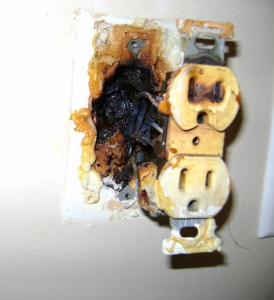 Establishing “Why” Since 1966
Establishing “Why” Since 1966
We use electricity as a part of our daily lives in our homes and at our places of business. Yet we often take for granted how powerful electricity is. Fortunately the number of electrical fires are decreasing overall, but they still account for one third of all residential fires.
The following facts outline a few points of what you need to know to keep yourself, and your family safe. Electrical fires involve the flow of electric current or static electricity and are often caused by electrical system failures, appliance defects, incorrectly installed wiring, misuse and poor maintenance of electrical appliances, and overloaded circuits and extension cords. Electrical fires often spread further and cause more injuries than other types of fires. That is because electrical fires that start in walls can smolder longer and spread within the walls traveling a great distance throughout the structure completely undetected.
Over the last thirty years, our homes have been drastically transformed by electrical devices which can easily overburden older homes’ electrical network with dated wiring systems. Thus these homes are at a higher risk of electrical fires. However, any home can become at risk for electrical fires with aged wire insulation, loosened connections, worn out receptacles or switches and dirty electrical components which are more likely to overheat. The key to keeping your family safe is awareness, smoke alarms with fresh batteries, having an evacuation plan, fire extinguishers and home maintenance.
Although electrical fires are common, they are often used as a scapegoat when determining the causation
of the fire, simply because electrical components are there. Circuit wiring, ceiling fans, and light fixtures are often misinterpreted as being the causation of the fire for the following reasons. Ceiling fans and light fixtures are often located on the ceiling and are therefore exposed to a great deal of heat and flames. These fixtures are often charred, but are not necessarily the source of the fire’s ignition. Electrical wiring that is often found to be melted in moderate to severe fires could have only been caused by extreme temperatures, arcing, and alloying. Fire temperatures great enough to melt copper wiring are rare in fires with minor to moderate damage so finding melted copper wiring could be a potential read flag. Melted wiring due to arcing does not necessarily mean the fire’s ignition was electrical in nature as a fire can result in arcing between two conductors.
Alloying is the most encountered condition and is often the most misunderstood by fire investigators. Alloying is often confused with melting due to extreme temperature and arcing.
It is important to determine which of these conditions caused the identified melting and why that condition was found at the scene.
The experienced fire scientists, engineers, and technical investigators at Forensic Analysis & Engineering collectively have over 100 years of fire investigative experience. Our investigators understand the devastating effects of residential, commercial, and marine fires. FAEC is uniquely situated to be able to quickly respond to the scene before crucial evidence disintegrates and to determine the causation of the subject fire. To find out more or to submit an investigation request, visit our website at www.forensic-analysis.com.


Recent Comments